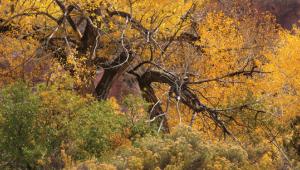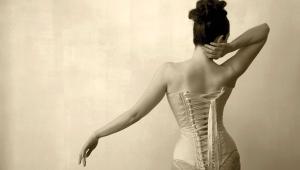Photo History: Color Images From The FSA: The Farm Security Administration Archives Reveal A Treasure Of Photographs

Jack Delano, September 1940
Library of Congress, Prints and Photographs Division

“There were almost fifty trucks in the line. Some had been waiting for twenty-four hours for the potatoes tobe graded and weighed.”
Jack Delano, October 1940
Library of Congress, Prints and Photographs Division
Among the photographers enlisted by FSA administrator Roy Stryker were Dorothea Lange, Walker Evans, Russell Lee, Arthur Rothstein, Jack Delano, Carl Mydans, John Vachon, Gordon Parks, and Marion Post Wolcott. Many later distinguished themselves at Life, Look, and other periodicals.
The Library of Congress (LOC) began archiving FSA pictures in 1944, and organized what eventually totaled about 107,000 black-and-whitenegatives and 1600 color slides plus larger transparencies. This collection quickly became popular with individuals who bought prints, and in magazines, newspapers, and books. Many photographers have been familiar with FSA black-and-white images, such as “Migrant Mother” by Dorothea Lange, but few of us knew about FSA color photos.
Helena Zinkham, Chief, Prints and Photographs Division, and colleagues at the LOC, filled me in on many aspects of the FSA color collection: “The fame and quantity of the black-and-white work, and its ease of reproducing continues to overshadow the color work.” The LOC solved problems of reproducing color shots in the 1980s, and digitizing has made distribution easier since 2004. A large number of color images are available at Flickr: www.flickr.com/photos/library_of_congress/sets/72157603671370361. Typical photos from the collection illustrate this story.
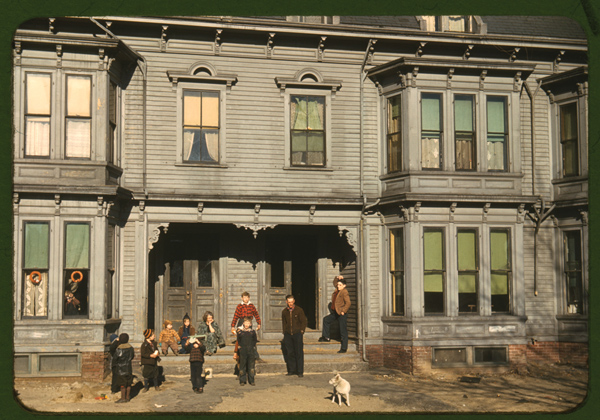
Jack Delano, December 1940
Library of Congress, Prints and Photographs Division
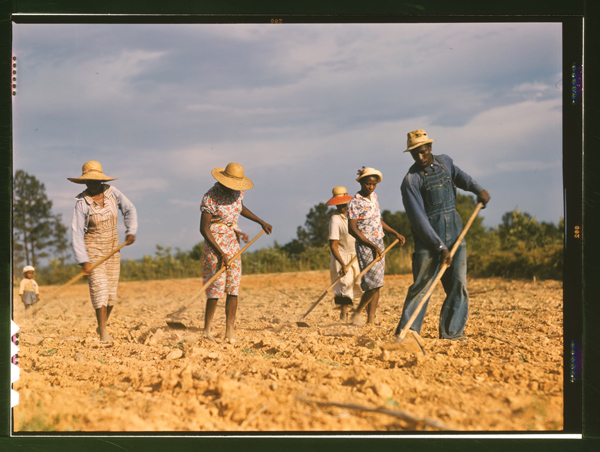
Jack Delano, June 1941
Library of Congress, Prints and Photographs Division

Russell Lee, October 1940
Library of Congress, Prints and Photographs Division
Zinkham says, “Each new audience delight to discover these rare color photographs… The growth of social media venues has expanded their use as well. When the Library contributed FSA color images to Flickr Commons, they experienced more than a million viewers in the first few days. Comments from the Flickr display have provided valuable new identifying information plus ‘history detectives’ who corrected information for some photo locations.”
Zinkham answered my questions to help illuminate facts about the “unknown” FSA color images:
Q: How has the FSA color collection been publicized?
A: In articles, exhibits, books, and special projects that have featured selected pictures.
However, the popularity of FSA black-and-white photographs seems to have overshadowed the color work.
Q: In a Wikipedia article nine FSA photographers are pictured. Did all of them shoot color?
A: Five of the nine shown have color work in the FSA collection: Jack Delano, Russell Lee, Arthur Rothstein, John Vachon, and Marion Post Wolcott. Of the others, Carl Mydans and Walker Evans left the FSA before color work began and Dorothea Lange left in 1939 when color was just starting. Gordon Parks stayed with black and white. Roughly 100 FSA stories involved color, with pictures covering 37 states plus DC, Puerto Rico, and the Virgin Islands.
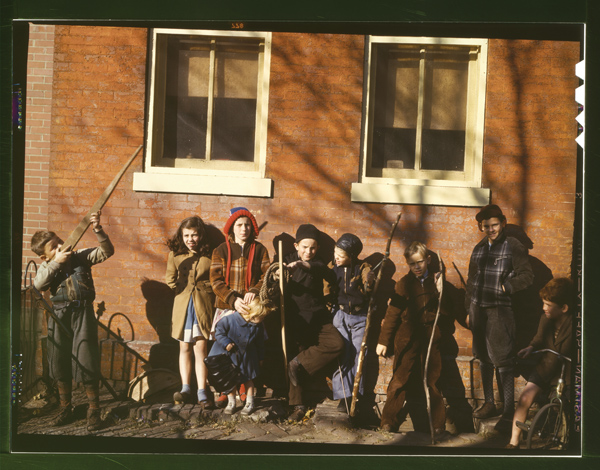
Not attributed in files, circa 1941-1942
Library of Congress, Prints and Photographs Division
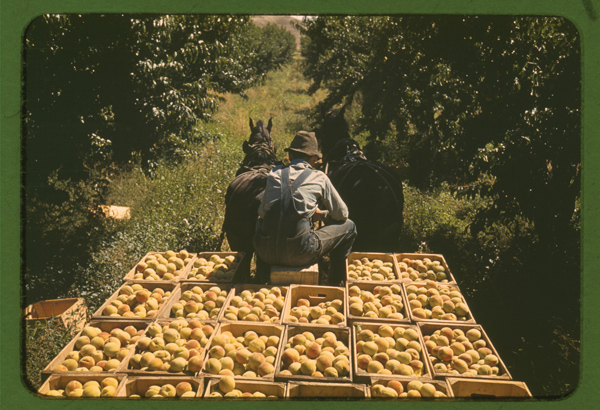
Russell Lee, September 1940
Library of Congress, Prints and Photographs Division
Q: Why were so few color pictures taken compared to black and white?
A: The expense of color film and the high cost of color reproduction in magazines limited color photography. Early association of published color reporting next to advertising pictures discouraged greater coverage. However, Kodachrome slide film, introduced in 1936, became part of the FSA legacy; sheet film came along in 1938. FSA began color coverage in 1939 and continued until 1944 when the agency’s mission was accomplished.
Q: What cameras did the FSA color photographers use?
A: Leica and Contax were the predominate 35mm cameras at that time, though over a thousand of the transparencies were taken on sheet film or roll film with Speed Graphics and Rolleiflex. Both Kodachrome daylight and Type B tungsten films were used.
Q: Are vivid Kodachrome colors a product of computer amplification?
A: There was no amplification. We aimed for clear image content because the photographers had very subjective goals. From our neutral scanning specification, publishers and other photographers can adjust images to their needs. We attempted to have slides and positive transparencies digitized to match the originals using calibrated light sources and monitors. We tried to keep the richness of the colors.
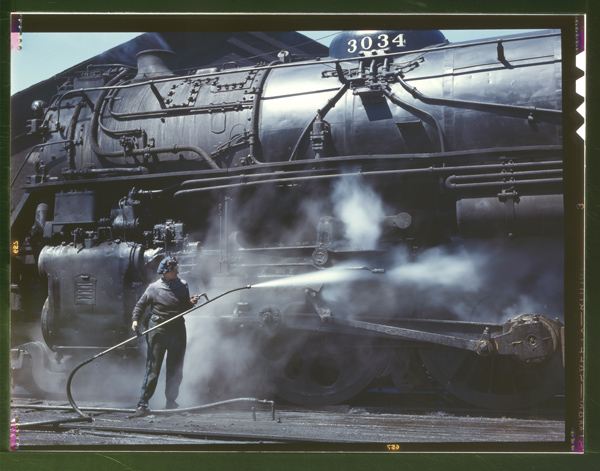
Mrs. Sievers is the sole support of her mother and has a son-in-law in the Army.
Jack Delano, April 1943
Library of Congress, Prints and Photographs Division
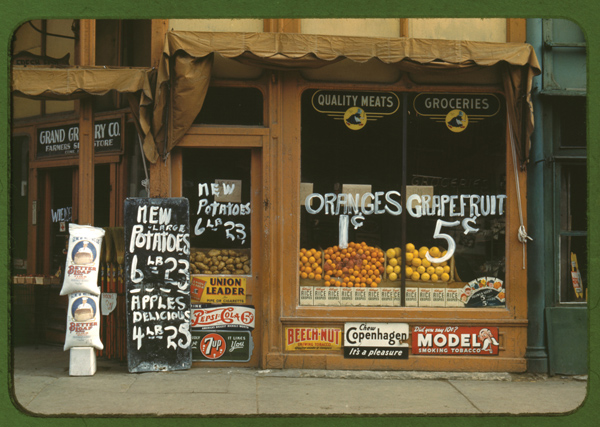
Photograph shows Rice Krispies cereal boxes in window below oranges; Better Loaf flour sacks at left next to sign for: New & large potatoes, 6lb. 23, apples, delicious, 4lb. 25.
John Vachon, 1942
Library of Congress, Prints and Photographs Division
(Author’s note: I have digitized Kodachrome slides made 65 years ago and the color is still very good, though not as vivid as the FSA photos that in the early 1980s went into cold storage vaults. The original Kodachrome was ASA 8, and didn’t hold shadow detail as well as in later improvements.)
Q: Did the FSA photographers shoot both color and black and white?
A: Beverly Brannan, LOC Curator of Photography: Many of the best-known color photos have black-and-white counterparts. My impression is that the photographers experimented to compare the advantages of each film type.
The largest series of black-and-white negatives is 35mm, suggesting that Leica and Contax were used for both color and black and white. Other black-and-white series were shot on a mix of 4x5, 2 1/4, and 3 1/2x4 1/2 films, along with a few 5x7 and 8x10 formats.
(Note: All Kodachrome had to be developed by Kodak in Rochester at that time.)
Q: Did FSA Director Roy Stryker assign specific story subjects, or did the photographers originate subjects for themselves?
A: Prints and Photographs Division photographers were given general assignments, often responding to requests from regional FSA offices, many of which were in rural areas. However, photographers also had some scope to photograph what they encountered on their assignments. Literature about the FSA often mentions “shooting scripts,” and we have included online those we have found. They can be found at: www.loc.gov/rr/print/.
We did not find scripts that directly correspond with all the FSA photographic assignments, and it’s likely that photographers received instructions in person or by phone. Stryker also wrote them letters that provided guidance.
Author Sally Stein in Documenting America says Stryker encouraged initiative, but not independence. The introduction to the book notes that: “Stryker outlined his requirements broadly… He urged them to photograph what caught their interest, even if it had no direct connection to the agency or its mandate.”

Russell Lee, August 1942
Library of Congress, Prints and Photographs Division
(Note: Walker Evans photographed many building facades in the South and irritated Stryker by being inaccessible at times. Dorothea Lange argued with Stryker about developing her own Rollei film at home.)
Q: Of the various books about FSA photographic efforts, did any of them include color pictures?
A: Barbara Natanson, LOC Head of Reference Services: While several books mention the color photographs, many books in past decades did not print in color. Printing production costs probably discouraged colorin books.
According to author Sally Stein, Stryker never succeeded in getting any of the color work published during the FSA years, but he also had difficulty getting black-and-white work published, too.
Writer David Peeler in his book Hope Among Us Yet: Social Criticism and Social Solace in Depression America, compared the color images—unfavorably—to the black-and-white images, and interestingly, even in 1987 his book doesn’t include any color illustrations.
Q: If photographers took notes about pictures, are these in your files?
A: Barbara Natanson: We find a few photographer comments about their work in the FSA written records at the Library of Congress, but they are the exception, not the rule. Author Sally Stein seems to have combed through pertinent written records at the Library of Congress, University of Louisville and elsewhere, and she cites letters between Stryker and photographers that mention their color work. She notes that “FSA photographers often were expected to defend their expenditures of time and materials, even more in the case of color.” Stein felt the photographers were ambivalent about using color, partly because they had to determine when it was most advisable to use. Photographers felt most confident about using color when they shot county fairs.
Sally Stein wrote about FSA photographers: “Their youth as well as their technical curiosity made them more eager than their boss to try a new form of photography.” She suggests that Russell Lee was more enthusiastic, and recommended color to Stryker starting in the late 1930s without a positive response from Stryker. When she interviewed Jack Delano, Russell Lee, Arthur Rothstein, and Marion Post Wolcott in the late 1970s, she felt they didn’t have clear memories of what they were trying to achieve with color photography.
My feeling is that the group of color photographs with this article indicates that color may have seemed like a foreign language to those four talented photographers. Today color has become a rewarding medium to most photographers and we have learned to think in color. It’s too bad the FSA pioneers didn’t live to enjoy digital capture.
Learn More
Editor’s note: There are numerous books and films on the subject of FSA photography. The images form a legacy that could certainly bear reexamination and emulation today. Among the many books we can recommend are:
• Dorothea Lange: A Life Beyond Limits (W. W. Norton & Company, 2009) by Linda Gordon
• In This Proud Land (NY Graphic Society, First Printing 1973) by Roy Stryker and Nancy Wood
• Documenting America (University of California Press, 1988) edited by Carl Fleischauer and Beverly W. Brannan
Notes on images: The captions are those found in the files associated with each image.—Editor






